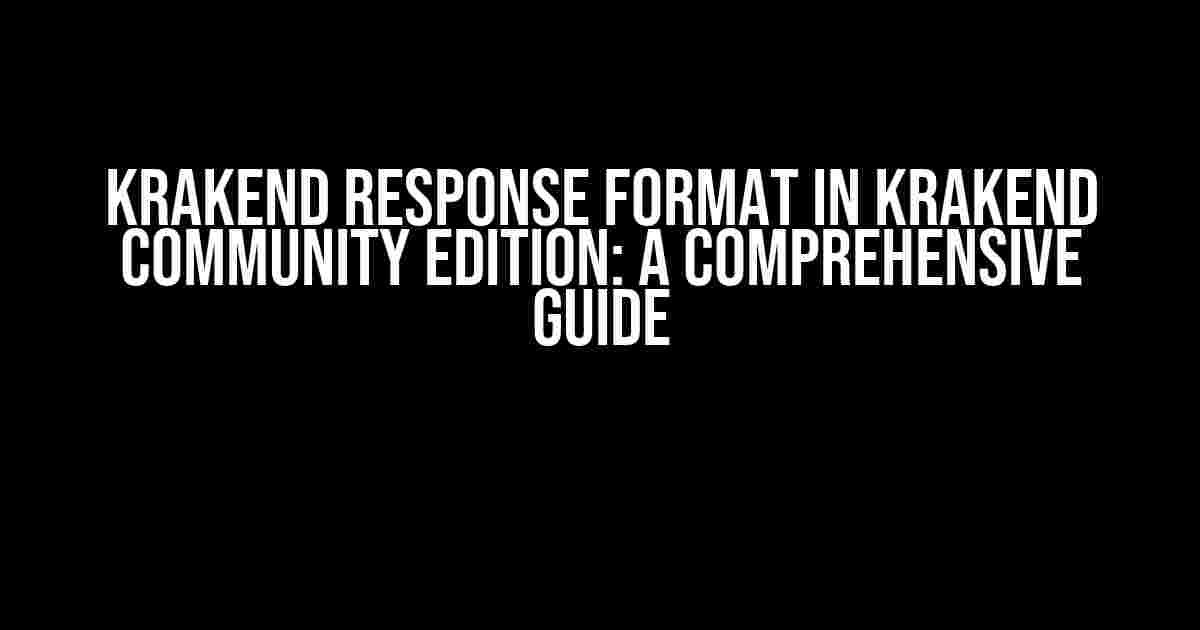Hey there, API enthusiasts! Are you tired of dealing with complex API responses in KrakenD Community Edition? Do you struggle to make sense of the KrakenD response format? Fear not, dear reader, for we’ve got you covered. In this article, we’ll take you on a journey to understand the KrakenD response format in KrakenD Community Edition, so you can streamline your API development and make the most out of this powerful API gateway.
What is KrakenD?
KrakenD is an open-source API gateway that enables you to design, deploy, and manage your APIs with ease. It’s a lightweight, flexible, and highly customizable solution that simplifies API development and integration. KrakenD Community Edition is a free, open-source version of the KrakenD API gateway, designed for developers and small teams.
Why is Understanding KrakenD Response Format Important?
Understanding the KrakenD response format is crucial for building efficient and scalable APIs. A well-structured response format helps you to:
- Improve API performance and reduce latency
- Simplify API development and integration
- Enhance API documentation and readability
- Boost API security and reliability
KrakenD Response Format Overview
The KrakenD response format is based on the JSON (JavaScript Object Notation) data interchange format. It’s a lightweight, human-readable format that’s easy to parse and generate. The KrakenD response format consists of the following elements:
{
"data": {},
"error": {},
"meta": {}
}
Data Element
The “data” element contains the actual response data from the upstream service. It can be a JSON object, array, or any other valid JSON data type.
{
"data": {
"user": {
"name": "John Doe",
"email": "[email protected]"
}
}
}
Error Element
The “error” element contains error information when the request fails. It’s an object with the following properties:
{
"error": {
"code": 404,
"message": "Not Found",
"details": "User not found"
}
}
Meta Element
The “meta” element contains metadata about the response. It can include information about the response time, cache control, and more.
{
"meta": {
"response_time": 200,
"cache_control": "public, max-age=3600"
}
}
Configuring KrakenD Response Format
To configure the KrakenD response format, you can use the KrakenD configuration file (krakend.json). You can customize the response format by adding or modifying the following sections:
{
"version": 2,
"output_encoding": "json",
"default_backend": {
"url_pattern": "/api/",
"encoding": "json",
"extra_config": {
"response_format": {
"data": "{ \"user\" : { \"name\" : \"$name\" } }",
"error": "{ \"code\" : \"$code\", \"message\" : \"$message\" }",
"meta": "{ \"response_time\" : \"$response_time\" }"
}
}
}
}
Best Practices for KrakenD Response Format
Follow these best practices to ensure a well-structured and efficient KrakenD response format:
- Use a consistent naming convention for your response elements
- Keep your response format minimal and focused on the essential data
- Avoid using complex data structures and nested arrays
- Use descriptive error messages and codes
- Document your response format using API documentation tools like Swagger or OpenAPI
KrakenD Response Format Examples
Here are some examples of KrakenD response formats for different use cases:
| Use Case | Response Format |
|---|---|
| User Profile |
{
"data": {
"user": {
"name": "John Doe",
"email": "[email protected]"
}
}
}
|
| Product List |
{
"data": [
{
"id": 1,
"name": "Product A"
},
{
"id": 2,
"name": "Product B"
}
]
}
|
| Error Response |
{
"error": {
"code": 404,
"message": "Not Found",
"details": "User not found"
}
}
|
Conclusion
In conclusion, understanding the KrakenD response format is crucial for building efficient and scalable APIs in KrakenD Community Edition. By following the best practices and examples outlined in this article, you can create a well-structured and customizable response format that meets your API requirements. Remember to keep your response format simple, consistent, and focused on the essential data. Happy coding!
Looking for more KrakenD resources? Check out the official KrakenD documentation and community forum for tutorials, guides, and discussions on KrakenD and API development.
Still got questions? Don’t hesitate to reach out to us in the comments section below. We’re always here to help!
Here are 5 questions and answers about KrakenD response format in KrakenD Community Edition:
Frequently Asked Questions
Get the scoop on KrakenD response format in KrakenD Community Edition – we’ve got the answers to your burning questions!
What is the default response format in KrakenD Community Edition?
By default, KrakenD Community Edition returns responses in JSON (JavaScript Object Notation) format. This is because JSON is a lightweight and universally accepted data interchange format that is easy to work with.
Can I change the response format in KrakenD Community Edition?
Yes, you can! KrakenD Community Edition allows you to specify the response format using the `output` section in your KrakenD configuration file. For example, you can change the response format to XML or even customize it to meet your specific needs.
How does KrakenD Community Edition handle errors in the response format?
When an error occurs, KrakenD Community Edition returns an error response in the same format as the request. For example, if the request was made in JSON format, the error response will also be in JSON format. This makes it easy for clients to parse and handle errors correctly.
Can I customize the error response format in KrakenD Community Edition?
Yes, you can customize the error response format using the `error` section in your KrakenD configuration file. You can specify custom error codes, messages, and even add additional error information to help with debugging.
Does KrakenD Community Edition support multiple response formats?
Yes, KrakenD Community Edition supports multiple response formats. You can configure KrakenD to return responses in different formats based on the client’s request. For example, you can return JSON format for web clients and XML format for mobile apps.

